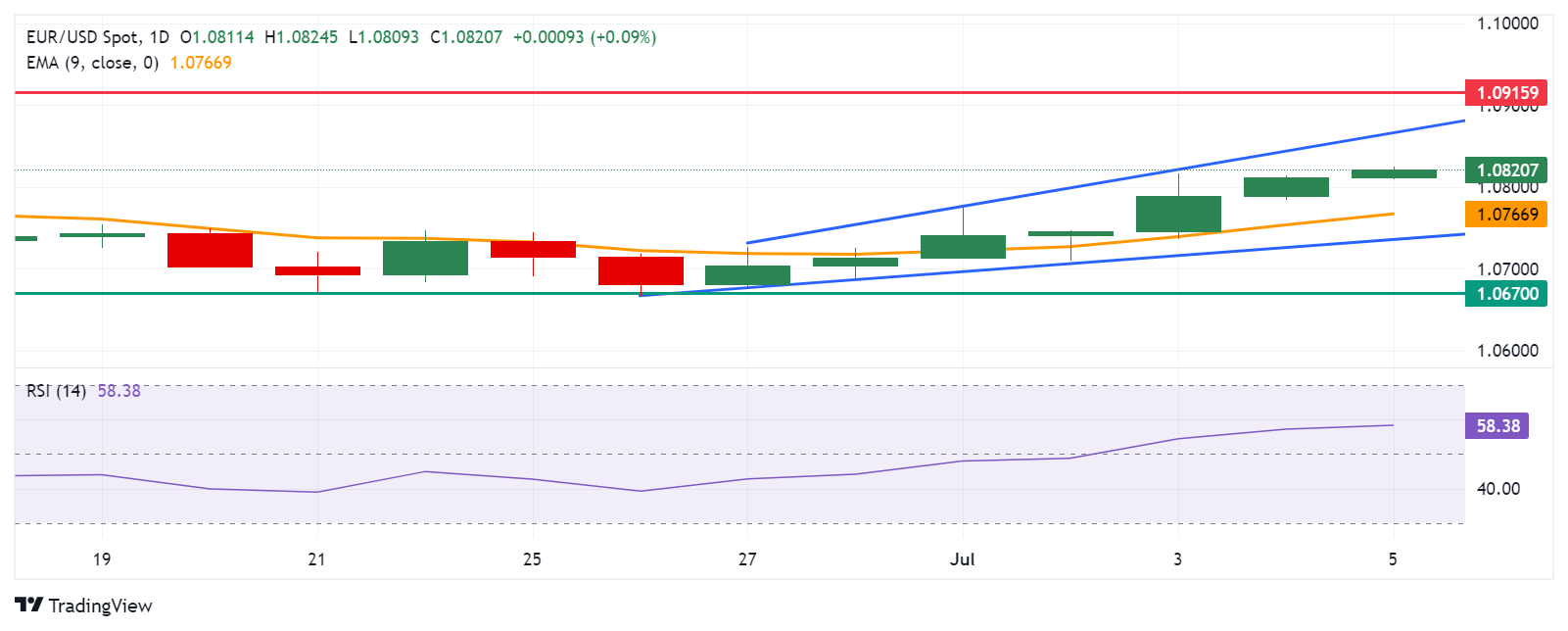EUR/USD Price Analysis: Moves above 1.0800; next barrier at upper boundary of the channel
- EUR/USD may test the upper boundary of the ascending channel around the level of 1.0870.
- The 14-day RSI suggests a confirmation of a bullish trend for the pair.
- The pair could find key support around the nine-day EMA at the 1.0766 level.
EUR/USD continues its winning streak for the seventh successive day, trading around 1.0820 during the Asian hours on Friday. A technical analysis of the daily chart indicates a bullish bias, with the pair oscillating within an ascending channel.
Additionally, the momentum indicator 14-day Relative Strength Index (RSI) is positioned above the 50 level, suggesting a confirmation of a bullish trend for the EUR/USD pair. Further, an increase toward the 70 level may strengthen the bullish bias for the pair.
The EUR/USD pair may encounter resistance at the upper boundary of the ascending channel around the level of 1.0870, followed by the psychological level of 1.0900. A break above the latter could strengthen the pair to revisit the three-month high of 1.0915.
On the downside, the EUR/USD pair may test the key support around the nine-day Exponential Moving Average (EMA) at 1.0766, followed by the lower boundary of the ascending channel around the level of 1.0730.
A break below the latter could exert downward pressure on the EUR/USD pair to navigate the region around the key level of 1.0670, which could act as a throwback support.
EUR/USD: Daily Chart

Euro FAQs
The Euro is the currency for the 20 European Union countries that belong to the Eurozone. It is the second most heavily traded currency in the world behind the US Dollar. In 2022, it accounted for 31% of all foreign exchange transactions, with an average daily turnover of over $2.2 trillion a day. EUR/USD is the most heavily traded currency pair in the world, accounting for an estimated 30% off all transactions, followed by EUR/JPY (4%), EUR/GBP (3%) and EUR/AUD (2%).
The European Central Bank (ECB) in Frankfurt, Germany, is the reserve bank for the Eurozone. The ECB sets interest rates and manages monetary policy. The ECB’s primary mandate is to maintain price stability, which means either controlling inflation or stimulating growth. Its primary tool is the raising or lowering of interest rates. Relatively high interest rates – or the expectation of higher rates – will usually benefit the Euro and vice versa. The ECB Governing Council makes monetary policy decisions at meetings held eight times a year. Decisions are made by heads of the Eurozone national banks and six permanent members, including the President of the ECB, Christine Lagarde.
Eurozone inflation data, measured by the Harmonized Index of Consumer Prices (HICP), is an important econometric for the Euro. If inflation rises more than expected, especially if above the ECB’s 2% target, it obliges the ECB to raise interest rates to bring it back under control. Relatively high interest rates compared to its counterparts will usually benefit the Euro, as it makes the region more attractive as a place for global investors to park their money.
Data releases gauge the health of the economy and can impact on the Euro. Indicators such as GDP, Manufacturing and Services PMIs, employment, and consumer sentiment surveys can all influence the direction of the single currency. A strong economy is good for the Euro. Not only does it attract more foreign investment but it may encourage the ECB to put up interest rates, which will directly strengthen the Euro. Otherwise, if economic data is weak, the Euro is likely to fall. Economic data for the four largest economies in the euro area (Germany, France, Italy and Spain) are especially significant, as they account for 75% of the Eurozone’s economy.
Another significant data release for the Euro is the Trade Balance. This indicator measures the difference between what a country earns from its exports and what it spends on imports over a given period. If a country produces highly sought after exports then its currency will gain in value purely from the extra demand created from foreign buyers seeking to purchase these goods. Therefore, a positive net Trade Balance strengthens a currency and vice versa for a negative balance.



